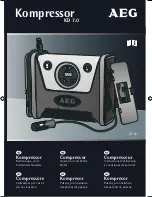
GB
13
Problem
Possible cause
Solution
Compressor motor does not start
Air compressor storage tank filled
Depressurise tank using the release valve
Air compressor storage tank is unable to sustain pressure
Air leaks at hose connection points.
Operate the air compressor at maximum pressure, turn off.
Apply soap solution to the connection points, and observe
for leaks. Tighten leaking connection points.
If problem persists, contact a qualified GMC technician
Air compressor is producing increased sound levels/vibration/
metallic knock
Oil level low
Immediately switch off the air compressor and fill with
approved oil
Bearing, piston or valve damage
Contact a qualified GMC technician
Excessive oil consumption
Oil level too high
Keep the oil level as specified in ‘Filling with motor oil’
Crankcase Breather (3) blocked
Remove and clean using a suitable cleaning product
Piston Ring/Cylinder worn
Contact a qualified GMC technician
Troubleshooting
1. Detach the Air Filter (15) from the Cylinder Head (4), by turning it anticlockwise
2. Remove the wing nut from the top of the Air Filter assembly, and remove the air filter
element from the inside of the assembly
3. Wash the filter element thoroughly in a solution of warm water with non-foamy household
detergent, or clean with a specialised non-flammable solvent
WARNING: DO NOT use petrol or other flammable solvents to clean the filter element, as this
could lead to fire or explosion.
4. Dry the filter element thoroughly
WARNING: DO NOT wring out the element, as this would damage the sponge material.
WARNING: NEVER install a wet filter element, as water in the air intake will lead to
permanent motor damage.
5. Immerse the dried filter element in clean motor oil, or alternatively, apply specialised air filter
oil to the filter element. Gently squeeze (but DO NOT wring out) to remove excess oil.
Note: If the filter element is installed soaked in excessive amounts of oil, the motor will
produce large amounts of smoke after being started.
6. Reinstall the Air Filter to the Cylinder Head. Ensuring that the air filter is securely
tightened into the intake port.
Motor oil maintenance
WARNING: Motor oil is a major pollutant and MUST NOT be allowed to enter the
environment. Dispose of according to local laws and regulations.
WARNING: Used motor oil can cause dermatitis and other skin disorders, including skin
cancer, if repeatedly left in contact with skin for prolonged periods of time. Wear suitable
gloves and thoroughly wash your hands and other exposed skin with soap and water as soon
as possible after handling used oil.
Note: Motor oil is best drained when the compressor is still warm. If the compressor is cool,
start and let it run for a few minutes, before changing the oil. This will lead to more rapid and
complete draining.
WARNING: Take special care not to touch hot motor parts.
Note: Motor oil is extracted and poured through the Crankcase Breather (3) hole
1. Ensure the ON/OFF Switch (6) is in the ‘OFF’ position
2. Remove the Crankcase Breather from the crankcase to reveal the crankcase breather hole
3. Place and oil suction gun (or syphon pump) receiver into the Motor Oil Fill Point. Operate
the oil removal tool to extract the oil
4. Refer to ‘Filling with motor oil’ for information on refilling
Storage
WARNING: Ensure the On/Off Switch (6) is in the ‘Off’ position, the power cord is
disconnected from the mains, and the air Reservoir Tank (1) is depressurised, before
transporting or storing the air compressor.
Transporting the air compressor
• This air compressor provides a Transport Handle (9) located at the front. Due to its weight
and size, the device should always be moved using the transportation handle and wheels.
Storing the compressor
• Store carefully in a secure, dry place out of the reach of children
Preparation for long-term storage
• Whenever the machine is out of use for an extended period of time, proceed as follows:
• Give the unit an overall cleaning and a thorough check
• Clean the air filter as described in ‘Air filter maintenance’
• Change the motor oil as described in ‘Motor oil maintenance’
• Protect all metal parts from corrosion by coating them with oil or a machinery preservative
Disposal
Always adhere to national regulations when disposing of power tools that are no longer
functional and are not viable for repair.
• Do not dispose of power tools, or other waste electrical and electronic equipment, with
household waste
• Contact your local waste disposal authority for information on the proper way to dispose of tools
• Oil must not be disposed of with household waste. Improper disposal may be regarded a
criminal offence in your country. Contact your local authority or dealer for correct disposal
procedures for oil
270120_Z1MANPRO1.indd 13
22/07/2014 17:03














































